- Home
- Michael Newton
The Texarkana Moonlight Murders: The Unsolved Case of the 1946 Phantom Killer Page 19
The Texarkana Moonlight Murders: The Unsolved Case of the 1946 Phantom Killer Read online
Page 19
An examination of [name deleted] personnel file was made at the office of the MK&T Railroad, at which time it was established that [4¼ lines deleted]. On the basis of this employment, it is considered that possibly [name deleted] was fingerprinted, and his prints would be on file with the Bureau.98
And so they were—but, once again, they did not match the Phantom’s latent prints.99
* * *
January 1950 brought another .32 Colt automatic to the FBI’s lab, sent by Sheriff Henslee from Bowie County. Ballistics technicians test-fired the gun and reported no match to the Texarkana murder weapon.100 Ten days later, Colonel Garrison sent a single slug and cartridge case for examination in Washington, again with negative results.101
Meanwhile, the parade of suspects continued, with a list of multiple names from Chief Runnels on January 16; another hundred-name list from Sheriff Henslee on January 24 (eighty-eight cleared, twelve without records); a single suspect submitted by Henslee on February 13; and another hundred names from the Dallas field office on March 29 (ninety cleared, ten without records). None cracked the case.102
* * *
On April 21, 1950, the abduction and rape of Los Angeles nursing student Carol Ann Cope made headlines nationwide. She had been on a date with boyfriend Robert Mueller when a gunman separated them, subjecting her to sexual assault.103 From Austin, DPS Director Homer Garrison, Jr. wrote to the Los Angeles Police Department six days later, seeking any information on potential links between that crime and Texarkana’s Phantom.104 On May 12, LAPD Deputy Chief Thad Brown sent Garrison the following response:
In reply to your letter of April 27, 1950, regarding suspect in kidnapping and rape of Carol Ann Cope, please be advised that this suspect is now in custody and has been positively identified by Miss Cope and her escort on that occasion, Robert Mueller.
The suspect in this case is a Cecil Frederick Reeves, L. A. No. 49318, S.Q. No. A 1909. He could not have been connected with your crimes as he was confined in San Quentin State Prison from April 12, 1945 until January 3, 1950, for conviction of robbery and grand theft.
He was held to answer for trial on our charges on May 10, 1950.105
Another dead-end. But if Reeves was not a Phantom suspect, many others were. The FBI’s Dallas field office collected a list of 106 names on May 4, 1950; ninety-six were cleared by fingerprints, while ten had none on file.106 A single suspect, submitted by Dallas on June 22, was cleared just as quickly.107
Fourteen weeks later, on October 3, headlines in the Schenectady Gazette announced another grim atrocity: “Teen-Aged Sweethearts Slain Near Amsterdam, Sex Maniac Suspected.” The victims were eighteen-year-old William Arthur Waterman and seventeen-year-old Jeanne Lorraine Stone, found dead on a lover’s lane outside Amsterdam, New York, on the morning of October 2. Waterman had been shot five times with a .22-caliber weapon while inside his car, then his forehead was crushed with a blunt instrument, presumed to be the killer’s rifle butt. Stone’s partially nude body was found twenty feet from the car, shot once in the head, raped after she was slain. Police dismissed robbery as a motive after finding small amounts of cash in both victims’ pockets. Detectives reported a similar attack near the same site three weeks earlier, wherein a “soft-spoken” rifleman accosted a Schenectady couple and raped the woman, while her date watched helplessly from the sidelines.108
Homer Garrison wrote to W. E. Kirwan, director of the New York State Police Crime Detection Laboratory, on October 4, seeking further information on that case, with the observation that “the circumstances as outlined in the newspaper release were quite similar to the double killings which occurred in Texas about four years ago and which remain unsolved.”109 Kirwan had nothing to offer, but a suspect was arrested in the New York case. Edwin A. Stone—a thirty-eight-year-old African American, unrelated to the female victim—pled guilty to Waterman’s murder in June 1951 and received a sentence of twenty to forty years in prison.110
In the meantime, Texarkana and America at large were distracted from cold cases by a flare-up in the Cold War, as North Korean troops crossed the 38th Parallel to invade South Korea on June 25, 1950. The United Nations Command (Korea) took charge of South Korea’s defense two days later, whereupon President Harry Truman dispatched U.S. military forces to Korea, under the command of General Douglas MacArthur. A see-saw “police action” ensued, with UN troops advancing nearly to the Chinese border, then retreating under fire to the 38th Parallel, where a stalemate ensued from July 1951 to the final signing of an armistice in November 1954.111
Seven months into that not-quite-war, Lone Wolf Gonzaullas received an anonymous letter postmarked from Dallas, dated January 11, 1951. It read, with spelling and grammar intact, as follows:
Lets talk a little about Texarkana. U.S.A.
Now that the war is picking up and Red River Arsenal will boom that place again, we will again hear songs like. Texarkana Baby. Texarkana here I Come, etc. and this Settlement will again boom like a oil town. I see where the law officers are again having trouble on the Texas side and lots of it.
What then-will that old Phantom murderer do. Or is he still alive. I was at Texarkana during all that boom-boom there and believe that this bird is still alive and lives and working there now. I may be wrong but I do not believe the real clue of clues was run down and the most important one was squashed like the old O’Dwyer case was several years back on the Arkansas side.
I am just recalling from memory the things that happened back then. The first attack on a couple (man & woman) in a park car resulted I believe in the man being harmed in a very unmannerly way. The woman was not attached but was run for a distant from the parking spot. The lady I believe lives now in Oklahoma claimed the man wore a mask, maybe so. Two weeks later this Phantom struck new the Owens place, killing the man and woman and from reports the woman was raped. Now for the real clue and supposed smart killer. Two weeks later the boy and girl at Spring Lake were killed and the girl was reported raped several times. I was at the scene the next morning after the car was being checked for finger prints, etc. and I did not hear of any house being checked or investigated in the nearby scene I believe this killer lives in the near vicinity of where the body of the boy was discovered and also the girl was taken into the home or hideout of the Phantom killer and rapped to his animal desire was satisfied. Her body was taken to a spot where the killer knows the woods, paths, etc. like a book. It was in my opinion dumped there and the killer returned to his home and locked and barred everything in the house and he sped away for a day or so. Now the Starks killing is believed to be separate from the other 4 but I am now convinced that it was the same bird that committed the other two murders. He probably fished a lot on the farm of Starks and knew Mrs. Starks and still had a desire not only to murder but to RARE her. He waited until almost the two weeks but struck on Friday night during a Texarkana Bear ball game and the reports are that most of the law officers were at a fish fry that night and drinking was plentiful. If these are a fact, the killer knew it and thought it a good opportunity to strike again. I believe the killer is over 50 years of age, a single only codger, stays drunk most of the time around his home and a wizard with guns. Also he works regularly there in Texarkana. Is an old time and nearly died with a heart attack about a few months after the killings.
Believe the night force in Texarkana, Texas did not investigate all the clews and dismissed them from their mind as not being it could’nt be him. Now the only way you will be able to find out it to send your own men up there quietly and investigate it for several weeks before this killer decides to strike again this spring when the petting parties might again park in their cars. I am not signing my name because I dont want to be a party to any investigation and if information above is a dud, then the innocent party should remain free and his name never mentioned. But you investigate and see if this is not a good lead. He still lives in the vicinity I told you about.
Just signed, John Doe112
While the u
nknown author used a British variant spelling for “clue,” nothing else about the letter suggests a foreign education—or much education at all, for that matter. Likewise, despite his (or her) apparent concern for an unnamed, possibly “innocent party,” the hints were insufficient to identify a suspect. Gonzaullas passed the letter on to second-generation Ranger Stewart Stanley in Clarksville, asking Stanley to “carefully read and digest the contents ... as there is a possibility of an angle that has not been thoroughly checked, but in all probability has.”113 As nothing more appears in ranger files about the incident, the lead apparently went nowhere.
* * *
On May 3, 1951—five years to the day after Virgil Starks’s murder—Lone Wolf Gonzaullas wrote a letter to DPS Director Homer Garrison, announcing his retirement from the Texas Rangers, effective on July 31. His plan was confidential, more or less, until Gonzaullas broke it to the press himself, on June 20. The Dallas Morning News ran an editorial on the Lone Wolf’s passing two days later, while 450 of the captain’s closest friends geared up for his retirement party on July 8, at the Koon Kreek Klub, outside of Athens, Texas, seventy miles east of Dallas.114
Critics of the exclusive Koon Kreek Klub, founded in 1905, suggest that its initials and inclusion of a racial slur are no mere accidents, in a state twice dominated by night-riding members of the Ku Klux Klan. A founder of the “klub,” General W. H. Patterson of Athens, had invited Britain’s King Edward VII to join in 1906, but Edward had passed on the honor and died four years later.115 “Normal” members, in the early 1950s, included oil tycoons Ike LaRue, Sid Richardson, George Greer, Clint Murchison, and others, plus the upper crust of corporate chairmen from Dallas–Fort Worth, who used the camp for hunting, fishing, and playing gin rummy for a modest $100 per point.116 Others often in attendance were the owners of the Dallas Morning News.117 Politicians also joined in the frolics, including Governor Bill Clements, first major client of Republican campaign strategist Karl Rove. Rove’s most famous candidate, George W. Bush, declined association with the KKK and purchased membership in the nearby—and equally all-white—Rainbo Club. When a Rainbo caretaker sued Bush and six other resort members in 1994, claiming wrongful termination after he was injured on the property, the club retained prominent Dallas attorney Harriet Miers (later an unsuccessful Bush nominee for the U.S. Supreme Court).118
Attendees at the Lone Wolf’s retirement bash included 200 high-ranking Texas lawmen and 250 business luminaries, gathered to wish Gonzaullas well in his next job—which would be taking him to Hollywood.119 Specifically, as he had told the Dallas papers back in June, Gonzaullas would be serving as a full-time technical advisor for Tales of the Texas Rangers, a dramatic radio series first aired by the National Broadcasting Company on July 8, 1950, produced and directed by Stacy Keach, Sr. Film star Joel McCrea appeared on-air as Ranger “Jayce Pearson,” pursuing outlaws on his faithful horse, Charcoal. From the outset of the series, scripts had been reviewed by both Gonzaullas and Director Garrison, in an attempt to “keep the record straight”—and, not so incidentally, to paint the rangers as a modern, scientific, even-handed band of law enforcers. The series ran until September 14, 1952, then made the leap to television three years later, with Willard Parker as Pearson, and Harry Lauter as fictional Ranger Clay Morgan.120
Despite his new career, Gonzaullas still retained an interest in ranger affairs. In May 1954, he told Arkansas Democrat reporter John Scudder that “the Phantom Slayer hunt was still on.” Since leaving show business behind, Gonzaullas had turned to manufacturing “protective gadgets,” among them “a hand-wound spring siren about the size of a large cigarette case.” Designed to fit in a pocket or purse, once triggered, the shrill siren wailed for five minutes nonstop and was audible ten blocks away. Gonzaullas told Scudder that his invention “arose out of the Phantom Slayer cases. A pocketbook siren would certainly have scared the Phantom off, particularly when he couldn’t turn it off.”121
Or, maybe not.
* * *
While Gonzaullas was peddling his gadgets in Dixie, on July 21, 1954, Detective Captain Wayne Bateman announced that a suspect had surrendered and confessed to the Phantom’s crimes in Shreveport, Louisiana. Robert Martin Chandler of Stamps, Arkansas, age “about thirty-six,” had turned himself in because his conscience “was bothering” him. To prove the point, he bared arms scarred from shoulders to fingertips with cigarette burns, self-inflicted over time as punishment for his crimes. Max Tackett went to question Chandler, warning reporters that his claims might be “nothing more than those of a crank, but we can’t take any chances.”122 So it proved to be, after what British author Colin Wilson called a “careful investigation.” Proved innocent, Chandler was freed with no charges filed.123
Two years later, in July 1956, workmen demolished an old school building in Spring Lake Park. In its attic, they found a man’s shirt, undershirt, and trousers marked with rusty-colored stains resembling dried blood. Could they have been the Phantom’s hunting garb? Packed off to the DPS crime lab in Austin, the garments were tested, reported to be free of bloodstains. Despite that verdict, Internet sources were still repeating the “bloody clothes” fable half a century later.124
And still, the search went on. On the night of August 15, 1956, a man named Willie Ed Bell was struck and killed by a train at El Dorado, Arkansas. Well known to law enforcement, Bell had a file including an FBI case number (4766333) and an Arkansas State Police number (136146). Local authorities could not decide if he committed suicide or came into the train’s path accidentally. On August 22, Captain Alan Templeton of the Arkansas State Police sent a copy of Bell’s fingerprints to the Texas Department of Public Safety, requesting that they be compared with latent prints found at the Phantom’s crime scenes. Homer Garrison found Bell in his own agency’s files (No. 476305), but reported back to Templeton on August 28 that “no identification was established” from the dead man’s prints.125
An FBI memo from July 1957 offers another tantalizing lead, rendered cryptic by censorship prior to release. According to that document: “On June 26, 1957, during the investigation of [1¼ lines deleted] for UFAP-MURDER, OO: Omaha, Chief of Police MAX TACKETT, Texarkana, Arkansas, was contacted by SA [name deleted]. TACKETT stated that above-captioned case, which took place in April, 1946, is still unsolved and that in view of the present activity of [name deleted] and his M.O., [name deleted] should be considered a suspect in the ‘Phantom Killer’ case.” Tackett requested a fingerprint comparison, which cleared Mr. X—and, once again, suggested lack of faith in his own claim that Youell Swinney was the Phantom.126
Later in 1957, Tillman Johnson retired from the Miller County Sheriff’s Department to become an insurance adjustor. He stuck with that profession until the early 1970s, when he began work as a private investigator for various local attorneys.127 Even then, he kept his interest in the Phantom case, telling anyone who would listen that he held Swinney responsible for four of the 1946 murders, excluding that of Virgil Starks.
Others remained unconvinced. The Phantom had passed into legend—at least, urban legend—with various supposed solutions to the case in circulation. Lubbock folklorist and Texas Tech professor Dr. Kenneth W. Davis heard one of the more popular tales in September 1958, and related it to Dallas Morning News reporter Kent Biffle thirty-eight years later.
“I was on my way to Nashville,” Davis told Biffle, “returning to graduate school. Near the western edge of Texarkana, I stopped for gasoline at a small Conoco filling station whose operator was a toothless gnome, but quite a talker. His failing eyes couldn’t quite read the official-looking parking sticker on my car that let me park on the Texas Tech campus. As he took my credit card, he asked, ‘You one of them laws come to keep an eye on that killer?’ I assured him that I wasn’t a ‘law.’ I asked if he referred to the famous Phantom Killer.”128
“That’s him,” the aged man replied, prompting Davis to ask, on a whim, if he knew what became of the killer.129
“With a conspiratorial look,” Davis went on, “he said, ‘The Texas Rangers, the highway patrol, and them local laws figgered out who was doin’ all that killin’, but they couldn’t get no real stout evidence on him. So, they went to that old boy’s rich momma and daddy and laid it on the line. Them laws told the killer’s folks that if they didn’t keep him locked up somebody would have to up and kill him and save the state a passel of time and money. So, his rich momma and daddy, they built a room on the back of that big old plantation house. Made it out of sheet steel and cement. They put a couple of windows in the room, but they’s bars as big as baseball bats over them. They’s no way that killer son could get out’n there.’”130
Davis naturally asked if his informant knew the palatial home’s location. “Not exactly,” the pump jockey replied. “But I got a purty good idee. Anyway, a few years after those folks locked him up because he was meaner’n hell, they died within a couple of months of each other. The momma died first. Some say it was a broken heart killed her. Some say she drank herself to death because that boy was locked up. The old daddy walked into a freight truck on the Dallas highway. It turned out them two had made a will and had a deal with the laws that if somethin’ happened they’d be money to keep watch over him till he died.”131
In a quirky twist, the old man added that at least twice a week a Texas Ranger or “one of ‘them highway cops’ stopped in the station to fill up with gas and buy a case or two of RC Colas. He’d heard the killer liked RC Colas.”132
As we saw in Chapter 8, Lone Wolf Gonzaullas was, himself, among local purveyors of this rumor, hinting to James Duke—and others?—that “although the local lawmen in Texarkana knew who the killer was, they wouldn’t arrest him because they had too little evidence, or the family was too rich and influential, or this rich family had agreed to maintain a private prison.”133

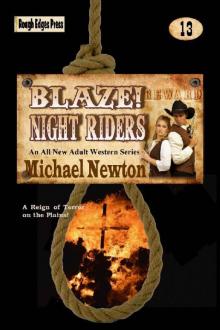 Blaze! Night Riders
Blaze! Night Riders How to Write Action Adventure Novels
How to Write Action Adventure Novels Blaze! Bad Medicine
Blaze! Bad Medicine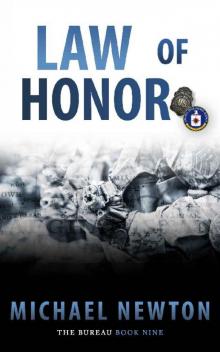 Law of Honor
Law of Honor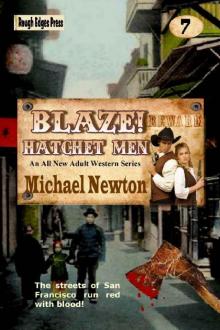 Blaze! Hatchet Men
Blaze! Hatchet Men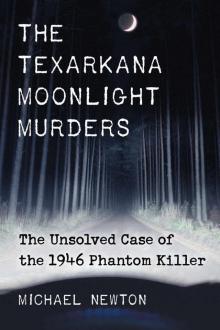 The Texarkana Moonlight Murders
The Texarkana Moonlight Murders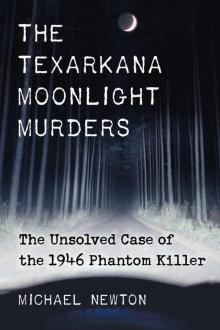 The Texarkana Moonlight Murders: The Unsolved Case of the 1946 Phantom Killer
The Texarkana Moonlight Murders: The Unsolved Case of the 1946 Phantom Killer